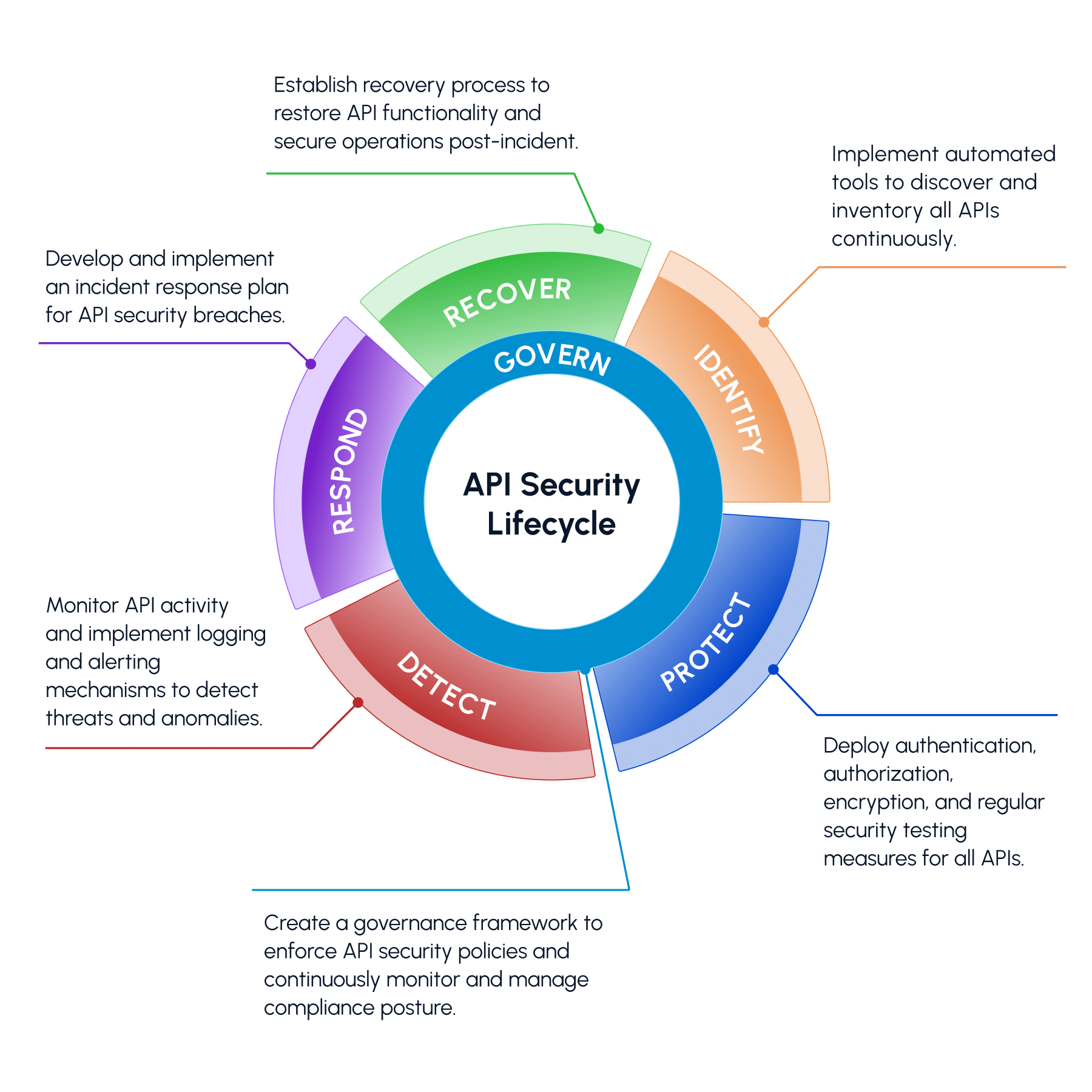APIs are the spine of contemporary functions, enabling seamless integration and information change. This makes APIs a main goal for cyberattacks. Based on Traceable’s 2023 State of API Safety Report, 60% of organizations skilled an API-related breach within the final two years. For those who’re a safety chief trying to enhance your group’s API safety posture and shield towards assaults focusing on APIs, organizing round a revered safety framework such because the NIST Cybersecurity Framework 2.0 will help you lay a roadmap in your group’s API safety journey.
The NIST Cybersecurity Framework (CSF) offers a complete strategy to managing cybersecurity dangers, together with these associated to APIs. By making the most of the NIST Cyber Safety Framework when designing and creating your API safety program, you are feeling assured that you’re taking the proper steps to successfully mitigate dangers and shield your important information and companies
The NIST Cybersecurity Framework and API Safety
The rise of microservice structure has led to an explosion of APIs, powering almost each interplay, integration, and switch of knowledge in trendy functions. This dramatic enhance in APIs has essentially expanded the applying assault floor. Whereas APIs provide great advantages by way of flexibility, scalability, and ease of integration, they will additionally open the door to important threats and abuse with out correct safety controls. Provided that many APIs present entry to delicate information and demanding assets coupled with the issue in successfully securing them, the enterprise penalties of an API-related breach are extraordinarily excessive. Subsequently, securing APIs is not only necessary however important to the general safety of your functions and enterprise operations.
The NIST Cybersecurity Framework 2.0 outlines the important thing capabilities and outcomes of a cybersecurity program. On this part, we’ll use the NIST Cybersecurity Framework as a basis to outline the important thing capabilities and outcomes of an API safety program. We’ll first define every of the important thing capabilities of the NIST framework. We’ll then discover key API safety actions that map to the framework.

- Establish: The group’s present cybersecurity dangers are understood.
- Defend: Safeguards to handle the group’s cybersecurity dangers are used.
- Detect: Doable cybersecurity assaults and compromises are discovered and analyzed.
- Reply: Actions relating to a detected cybersecurity incident are taken
- Get better: Property and operations affected by a cybersecurity incident are restored.
- Govern: The group’s cybersecurity danger administration technique, expectations, and coverage are established, communicated, and monitored.
Understanding the API Safety Lifecycle
The API safety lifecycle parallels the levels of the NIST framework, offering a structured strategy to securing APIs at each stage, from improvement to deployment and past. A properly designed API safety program derived from an entire safety lifecycle entails steady processes to establish, shield, detect, reply to, and get well from API safety threats. As this system conforms to the NIST framework extra intently over time, the safety outcomes turn into extra predictable and constant.
API Safety – Establish:
Step one when constructing an API safety program is to catalog and assess all APIs inside your group, together with inside, exterior, and third-party APIs. The safety and improvement organizations should conduct danger assessments to grasp potential vulnerabilities in all found APIs. Implement automated instruments to constantly uncover and stock all deployed APIs thus sustaining an up-to-date catalog of APIs, together with variations and endpoints, and figuring out unmanaged or rogue “shadow” APIs that would pose safety dangers.
Key Takeaway: Implement automated instruments to find and stock all APIs constantly.
API Safety – Defend:
Upon getting a fairly full catalog and danger measurement functionality in place, an API safety program ought to require safety measures equivalent to authentication, authorization, encryption, and common safety testing to safeguard APIs. Performing automated and handbook dynamic software safety testing (DAST) to establish runtime vulnerabilities in APIs and simulating assaults to check the resilience of APIs towards widespread threats provides robustness to the safety phase of the API safety lifecycle. Lastly, validating that APIs deal with sudden inputs gracefully with out exposing delicate data is required for full safety.
Key Takeaway: Deploy authentication, authorization, encryption, and common safety testing measures for all APIs.
API Safety – Detect:
Proactive detection of assaults and vulnerabilities is required throughout this part of the framework. Enterprises ought to monitor API exercise to establish suspicious conduct or potential breaches in real-time. They need to additionally use logging and alerting mechanisms to trace API utilization and detect anomalies. Capturing detailed logs of API requests and responses, together with headers and payloads, and storing these logs in an API safety information lake to help menace looking, detection, and investigation ends in the most effective potential to detect assaults over time. Proactively trying to find indicators of compromise (IOCs) and superior persistent threats (APTs) inside API visitors helps forestall assaults, not simply decide points publish reality.
Key Takeaway: Monitor API exercise and implement logging and alerting mechanisms to detect threats and anomalies.
API Safety – Reply:
Incidents are going to occur. It’s unattainable to stop each trendy assault and menace state of affairs. Enterprises should develop a response plan to deal with and mitigate safety incidents involving APIs whereas specializing in enterprise resilience and safety concurrently. This contains real-time blocking of malicious exercise and executing incident response protocols within the occasion of a profitable assault. Configure the alerts for safety incidents primarily based on predefined thresholds and guidelines, making certain alerts present actionable data to facilitate fast response, and integrating alerting with incident administration methods equivalent to a SIEM or SOAR platform to streamline response processes.
Key Takeaway: Develop and implement an incident response plan for API safety breaches.
API Safety – Get better
Restoration is a crucial step in an API safety program. With out restoration it’s unattainable to return to regular safe enterprise operations in a well timed method. Enterprises should guarantee sturdy restoration processes are in place to revive API performance and safe operations post-incident. Safety groups ought to doc classes realized, execute desk prime workout routines and replace safety measures to match new findings. Conducting detailed investigations of API safety incidents to find out the foundation trigger and affect, analyzing sequences of API calls, traces, and different proof to reconstruct assault vectors and timelines is required to construct a restoration plan. Making use of updates to repair recognized vulnerabilities in APIs and implementing configuration adjustments to reinforce safety and stop recurrence of incidents helps shift the issue earlier within the improvement lifecycle mitigating future enterprise danger.
Key Takeaway: Set up restoration processes to revive API performance and safe operations post-incident.
API Safety – Govern:
When utilized to API safety, the “Govern” perform within the NIST mannequin entails establishing a governance framework to make sure constant software and upkeep of safety insurance policies throughout the group. This contains creating and imposing API safety insurance policies, implementing role-based entry controls, managing compliance with rules like GDPR and HIPAA, offering ongoing safety coaching, and establishing metrics for measuring coverage effectiveness. Moreover, it encompasses managing third-party dangers and making certain a steady enchancment course of. A powerful API safety expertise platform aids these programmatic efforts by providing complete visibility, management, and reporting capabilities to help coverage enforcement and compliance demonstration.
Key Takeaway: Create a governance framework to implement API safety insurance policies and constantly monitor and handle compliance posture.
Conclusion
Organizing API safety across the NIST Cybersecurity Framework offers a structured and complete strategy to managing API-related dangers. By clearly defining the API safety lifecycle and mapping obligations to every perform of the NIST framework, organizations will be sure that their APIs are well-protected towards rising threats. With the collaboration of all related stakeholders, from product safety groups to SOC analysts and compliance leaders, companies can create a sturdy API safety technique that enhances resilience and protects important information and servicesBy following these tips, your group can leverage the NIST Cybersecurity Framework to attain the next stage of API safety, making certain that your APIs stay safe and your online business operations proceed with out disruption.
About Traceable
Traceable is the business’s main API Safety firm serving to organizations obtain API safety in a cloud-first, API-driven world. Traceable is the one contextually-informed resolution that powers full API safety – API discovery and posture administration, API safety testing, assault detection and menace looking, and assault safety wherever your APIs reside. Traceable permits organizations to attenuate danger and maximize the worth that APIs convey to their clients. To study extra about how API safety will help your online business, go to https://www.traceable.ai/.


